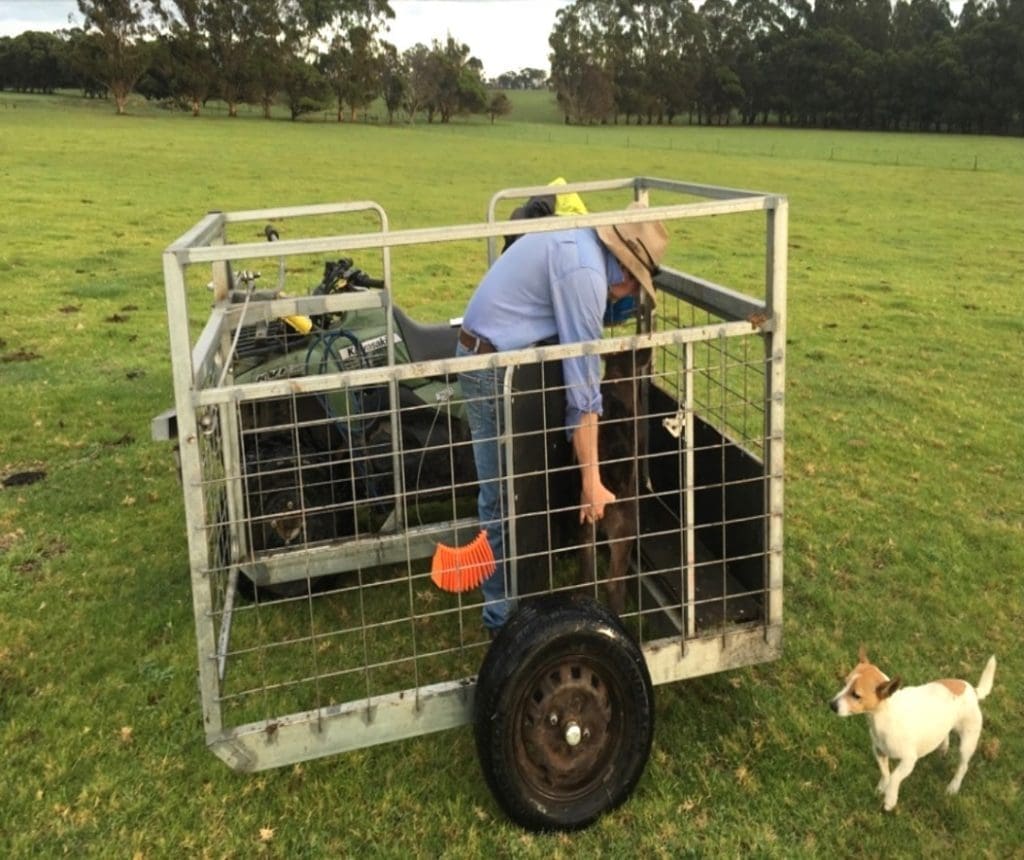
Wagyu calf being processed in Irongate’s calf-catcher. The calf enters the enclosure via the swing-gate entrance, at the left hand side of this photo.
WITH Breedplan performance recording continuing to grow in seedstock herds across Australia, new equipment is starting to emerge which helps in the often-laborious process of capturing newborn calves in the paddock to record birthweights, in order to generate EBVs for growth and birthweight.
Several motorised calf-capture units have been seen recently, providing different approaches to the task. All are designed to be single person operated.
In Western Australia, Wagyu breeder Peter Gilmore from Irongate Wagyu and his manager Mark James have over the past two years developed a calf-capture unit mounted beside a standard four-wheeler quad bike or larger side-by-side farm transport vehicle.
Capturing birthweights on foot is not only laborious, but new mothers tend to be cranky when someone approaches on foot, threating to tamper with their newborn.
“We were keen to capture all of the Breedplan data that we possibly could, and birthweight is a fundamental part of that,” Peter Gilmore said.
Manager Mark James researched what was happening overseas in the US and the UK in the same space, and devised and built the prototype of the unit pictured below. The video, accessible below, of the system was shown to delegates attending the recent 2016 Wagyu Conference in the Hunter Valley.
Irongate runs large numbers of Fullblood Wagyu breeders, as part of a herd of 2500 head. Employing fixed-time AI programs mean large numbers of calves are often hitting the ground in a short time-frame.
The calf capture unit is a rigidly-mounted enclosure beside the four-wheeler or side-by-side vehicle, with a swing gate. The operator drafts-off the calf, and closes the remotely-controlled gate in front of it as the enclosure surrounds it.
“We’ve found it enables quick, safe and efficient calf-catching in the paddock for Breedplan recording and other work,” Mr Gilmore said.
Birth weights are recorded using a Tru-test load bar and reader, but a number of other essential tasks are carried out at the same time – checking calf condition and sex, adding the NLIS tag and visual ear-tags, taking a DNA tissue-sample for UQ for MIP DNA parent verification and AWA registration, administering a pro-biotic for scours management and B12 and Multimin, and confirming mother-up at release.
Irongate now uses two of the units, to manage peak load times during calving season. It’s not hard for an operator to process 50 or more calves in a few hours, without any need to bring cows into the yards, Mr Gilmore said.
“Every now and again, a calf will get bowled over in the process of capture, but none have sustained any injury. We’ve worked hard to ensure that corners are rounded and there is protective rubber cushioning where necessary,” Mr Gilmore said. “We haven’t had a calf yet that hasn’t been able to get up and run off after processing.”
“It’s allowing us to perform that capture in the ideal 36-48 hour window after birth,” he said.
Irongate has built an additional unit, which will be auctioned for charity later this year. More details on Beef Central later.
Lariat unit on a large scale
In Narooma, NSW, stock handling equipment manufacturer Lariat Engineering has developed a somewhat similar unit, built on a larger scale for use coupled to a farm ute or four-wheel drive.
Lariat’s calf-capture unit, pictured in the video below, has an enclosure large enough to allow walk-in access for the cattlemen, while the calf can be released to its mother using a remote gate release inside the ute cab.
https://youtu.be/t2GYdfPyUmQ
The unit is easily detachable from the vehicle in the paddock to protect sick stock and hold for treatment.
“In the case of a sick animal, the same process applies however the cage can be detached and left surrounding the animal, offering protection where it can be fed, watered and treated and while this is going on the vehicle can be used for other things.”
Lariat says processing safety is an important feature, guarding the operator against protective mother cows.
The Calf-harvester was developed in conjunction with NSW Santa Gertrudis bull breeder Peter Atkinson at his Wonga Stud near Yeoval. Field testing this year has seen more than 550 calves from Wonga’s 2016 drop processed.
In operation, the calf-harvester cage is lowered to the side of the light truck by the use of remote controlled, electric actuators from within the cab, and the gate opened. The truck is then manoeuvred to catch the calf and once it is inside the cage, the gate is closed and the vehicle and calf slowly stopped.
The calves can then be processed for needling, tagging, branding, weighing and so on without the interference of its protective mother.
“Early intervention in cattle management is all but impossible under present regimes,” Lariat’s website says. “Matching cows to their off spring in the yards is a hit and miss exercise, birth weights go unrecorded, the ideal time to cauterise horn nodes is missed and the ideal time to brand and vaccinate is missed,” it says.
Click this link to learn more about Lariat’s calf catcher unit.
